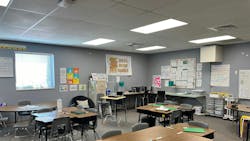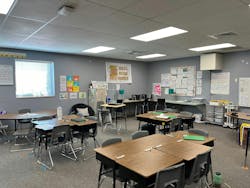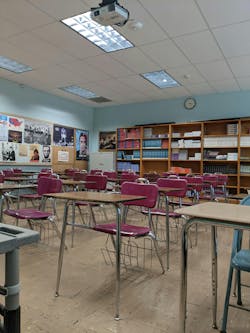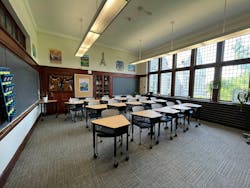The Lagging Transition to LEDs in Schools – Part 1 of 3
This article series looks at the current situation from the perspective of school facility personnel. Part 1 covers the transition to LED technology. Part 2 will identify changes coming to the lighting market, and Part 3 will offer thoughts for practical paths forward for LED systems in schools.
Although commercial LED lamps and luminaires have been available for more than a decade, educational facilities have been slow to adopt LED technology. As of 2020, 78% of the lighting in U.S. educational buildings was still fluorescent, according to the most recent estimates from the U.S. Department of Energy (DOE) Solid-State Lighting program in the “2020 U.S. Lighting Market Characterization” report.
Over the past year, lighting team members from Pacific Northwest National Laboratory (PNNL) have been walking through K-12 school corridors and classrooms to learn more about the day-to-day facility operations of schools. The scene is familiar: in the background, the lively voices of children playing and learning. Colorful graphics line the walls with encouraging messages and the latest artwork — a welcome contrast to the clean, sleek environment of many offices.
The lighting itself recalls our many days in school: fluorescent troffers and wraparounds, with the occasional pendant. While most visitors look at the inspiring imagery — not the luminaires — we are walking the halls to understand why fluorescent lighting is still so prevalent in schools across America.
School facility personnel recognize the energy benefits of an upgrade and tout the long life and reduced maintenance associated with solid-state technology. However, many reasons schools have been the slowest to adopt LED among all commercial building types became clear as PNNL continued conversations with school facility personnel.
The following highlights what has been learned from visiting more than 25 small and large school districts in 15 states, including cities and rural areas, with varying ranges of resources.
Fluorescent: a familiar system
For many facility personnel responsible for the daily maintenance of school buildings, linear fluorescent technology has been stable for their entire career. Since the adoption of T8 lamps and electronic ballasts began 40 years ago, there has been little meaningful change in fluorescent lighting systems. When fluorescent lamps fail, the person cleaning the classroom usually switches out the lamp. If the lamp still doesn’t work, then changing the ballast is another relatively simple step to take. These components can be acquired at a local hardware store or online and offer generally straightforward compatibility.
Most facility personnel also know what to expect in terms of light output, lifetime, and maintenance from their existing system. Practically, current fluorescent technology provides adequate lighting in terms of amount, color, and visual comfort.
Competing priorities and limited resources
With other maintenance issues and aging building systems to manage, replacing a well-understood and mostly functional fluorescent lighting system rarely makes it to the top of a priority list. PNNL heard from seasoned school facility managers who have been tasked with operating original boilers from the 1930s, updating schools with little insulation and few operable windows, or repairing burst pipes after a winter storm. There were many instances of states adding requirements or regulations that were underfunded, or not funded at all, that fell under the facility managers’ responsibility. Examples range from restricting the use of certain HVAC refrigerants to adding dispensers in bathrooms and supporting student recycling programs.
Schools generally want to support equipment upgrades, but with many other competing priorities and a lack of funding — combined with a short timeline — they are forced to either make a quick, first-cost-based decision or hold off on the change as long as they can before they are fined.
One facility manager noted that they could spend a million dollars at each of the nearly 40 schools in the district and still not fix or update everything they would like. Some schools have leveraged state or federal funding opportunities, fund-matching grants, utility rebates, or portions of their often shrinking maintenance funds to support the lighting upgrades, which are typically not completed all at once. The phased approach is partially due to high upfront costs but also speaks to the limited availability of qualified staff or contractors needed to complete lighting upgrades.
It’s not so simple
For schools, the attempt to contain cost, labor, and maintenance practice suggests the need for better lighting options. All but one LED upgrade option (Type A TLEDs) should be completed by a licensed electrician. Of the schools PNNL has interviewed so far, approximately half do not have an electrician on staff. One school district in the Northeast has had a position open for over a year without any qualified candidates.
In one school district, the fire marshal required a full system replacement after several fluorescent luminaires caught fire. However, LED systems have risks of their own. For example, Type B or “ballast bypass” TLEDs can be single or double-ended, meaning only one socket of the two remaining fluorescent sockets supplies power, while the other acts as a lamp holder. Over time, someone could unwittingly install Type B TLEDs with different wiring configurations or different TLED type, or even a fluorescent lamp that may create a shock or fire hazard. These concerns can be mitigated through labeling and sufficient staff training; however, safety concerns may be perceived as an immediate barrier with LEDs.
Despite the safety concerns, Type B TLEDs were the most commonly installed lighting technology in the participating school districts that have started upgrading. TLEDs offer a low first cost and a familiar maintenance routine after the initial modification. Removing the existing fluorescent ballast, rewiring, and installing the new lamp takes about 15 minutes to complete. Based on initial lab and field measurements collected by PNNL, Type B TLEDs may also be prone to flicker, which can be uncomfortable or distracting, and potentially cause harm to students or staff.
From compatibility issues to the availability of replaceable components, other technology options have trade-offs as well. Most schools that have installed new fixtures with integral LEDs mentioned they are struggling to replace inoperable products. Without replaceable components, the entire upgrade will have to be repeated (potentially without a utility incentive) and the same product may or may not still be manufactured. Schools must address cost, maintainability, safety, and quality when upgrading their lighting systems.
Upcoming changes
While most schools PNNL visited had some experience with LEDs, very few had completed wholesale replacements. With fluorescent bans set to go into effect across 10 states in the coming years, schools may have to add lighting to the list of upgrades they will have to face sooner than they anticipated. When we spoke to facility personnel in states with upcoming bans, they were largely unaware of the pending requirements and their timing. Regardless, facility managers in those states seemed sure that they would have everything replaced before it became an issue. Some facility managers had a plan in place to upgrade to LEDs as the existing fluorescent lamps failed, while others suggested that there were no plans to update the lighting for a while.
The general feeling of, “We have fluorescent, we’re fine,” may change as the situation evolves. Stay tuned for Part 2 of this series where we discuss these upcoming changes to the lighting market regarding fluorescent availability and utility rebates.
About the Author
Jessica Kelly
Jessica Kelly is a lighting research engineer at Pacific Northwest National Laboratory.
Andrea Wilkerson
Andrea Wilkerson is a lighting research engineer at the Pacific Northwest National Laboratory.
Dan Blitzer
Dan Blitzer is principal of The Practical Lighting Workshop, a consultancy in marketing and education for the lighting industry.



